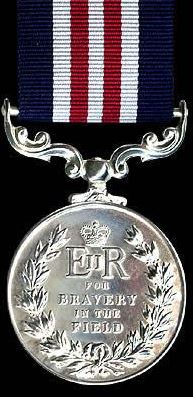Military Medal

The Military Medal was established on 25 March 1916. It was awarded to other ranks including non-commissioned officers and warrant officers, and ranked below the Distinguished Conduct Medal (DCM) However, the allowance was only awarded once even if the recipient was awarded more than one gallantry award.
The Military Medal was established on 25 March 1916. It was awarded to other ranks including non-commissioned officers and warrant officers, and ranked below the Distinguished Conduct Medal (DCM). Awards to British and Commonwealth forces were announced in the London Gazette.
When the medal was first introduced, it was unpopular among regular soldiers wrote MM and DCM recipient Frank Richards who stated “the Military Medal, which without a shadow of a doubt had been introduced to save awarding too many DCMs. The old regular soldiers thought very little of the new decoration”. Both the DCM and the MM attracted a gratuity and the decoration allowance of an extra sixpence a day to veterans with a disability pension. However, the allowance was only awarded once even if the recipient was awarded more than one gallantry award. The ratio in the First World War was approximately five MMs awarded for every DCM.
Since 1918 recipients of the Military Medal have been entitled to the post-nominal letters “MM”.
Eligibility was extended to soldiers of the Indian Army in 1944.
The Military Medal was discontinued in 1993
More information
From September 1916 members of the Royal Naval Division, serving on Western Front alongside the Army, were made eligible for military decorations, including the Military Medal, for the war’s duration. It could also be awarded to members of the Royal Air Force for gallant service on the ground
Eligibility for the MM was extended, by a Royal Warrant dated 21 June 1916, to women whether British subjects or foreign, with the first awards gazetted on 1 September 1916. Although nurses of the Queen Alexandra’s Imperial Military Nursing Service (QAIMNS) and the Territorial Force Nursing Service (TFNS) and other women serving with the British Army often had the social status of officers, they did not hold an officer’s commission and were therefore ineligible for the Military Cross, but could and were awarded the MM.Louisa Nolan, a civilian during the Easter Rising in Dublin, was awarded the Military Medal for her courage under fire in providing humanitarian aid to the wounded.
AS part of the review of the British honours system, which recommended removing distinctions of rank in respect of awards for bravery. Since then the Military Cross, previously only open to Commissioned and Warrant Officers, has been awarded to all ranks. The MM had also been awarded by Commonwealth countries but by the 1990s most, including Canada, Australia and New Zealand, were establishing their own honours systems and no longer recommended British honours.
Honoured
John Crookes
789725 W/Sergeant
John Crookes
Military Medal
5 Bomb Disposal Company
Royal Engineers
The Recommendation is taken from file WO373/56/165 held at the National Archives.
Placed in the London Gazette on 20 January 1946. Supplement 37442. Page 642.
This N.C.O has been the Platoon Sergeant of a sub-unit of this Company throughout the campaign. During the whole of this time, he has displayed powers of leadership of a high order and was largely responsible (by his example of personal fearlessness and devotion of duty) for maintaining the high morale of his platoon in very exacting circumstances.
For several weeks last summer in NORMANDY, the platoon was engaged on continuous minefield clearance operations in the CAUMONT area under very trying conditions. The whole region was thickly strewn with all types of mines – German, British, and American, without any adequate records as to how or where they were laid. Accidents were occurring at frequent intervals to civilians, members of other army units, and within the unit itself, whilst engaged on actual mine clearance. There was one such accident in Sgt Crookes Platoon.
In spite of all these hazards, the Platoon continued its slow deliberate nerve trying progress, day by day, accounting during the period 21/August 44 to 16/October/44 for a total of 6,843 mines cleared. This excellent record of achievement was due in no small measure to Sgt. Crookes leadership and his personal share in the work of actual clearance and location of minefields.
On another occasion near MEPPEN in Germany in APRIL 1945, whilst operating in support of “T” Force, a Utility in which this NCO together with his Platoon Commander, another NCO, and Driver, were driving, was ambushed and fired on by enemy machine-gun posts from very close range. The vehicle was evacuated but Sgt. Crookes remained in the back of the truck, which by this time was being riddled with bullets and with accurate rifle fire enabled the other three occupants to reach safety where he later rejoined them. This complete disregard of his own safety was typical of this NCO’s high sense of duty and personal bravery which was a source of admiration to his Officers and inspiration to his me.
Recommended by Major Royal Engineers, OC 5 Bomb Disposal Company for the Military Medal.
G. H . C Pennycook. BGS “T” Forces.
A. Galloway Major _ General C of S 21 A sp
Dated 24 January 1946.

About Us
The aim of the site is to provide a meeting point for all those involved in Explosive Ordnance Disposal (EOD) or Search whether serving or ex-serving members of the Royal Engineers and a source of material for those researching the work of the Royal Engineers or family history
Links
Donate
If you wish to donate to the running of the branch, please use the button below.
Terms & Conditions | Privacy Policy | Copyright © 2023 The Royal Engineers Association.
All rights reserved.

